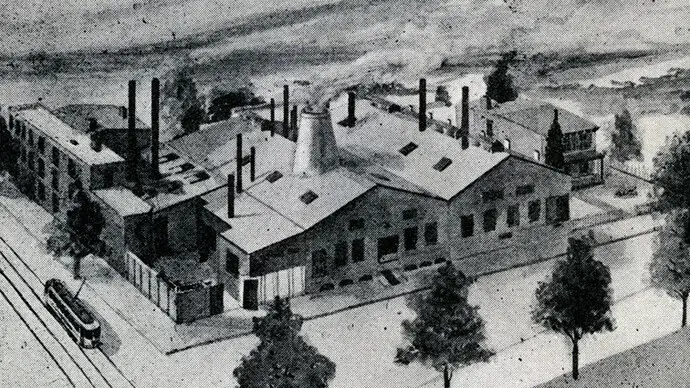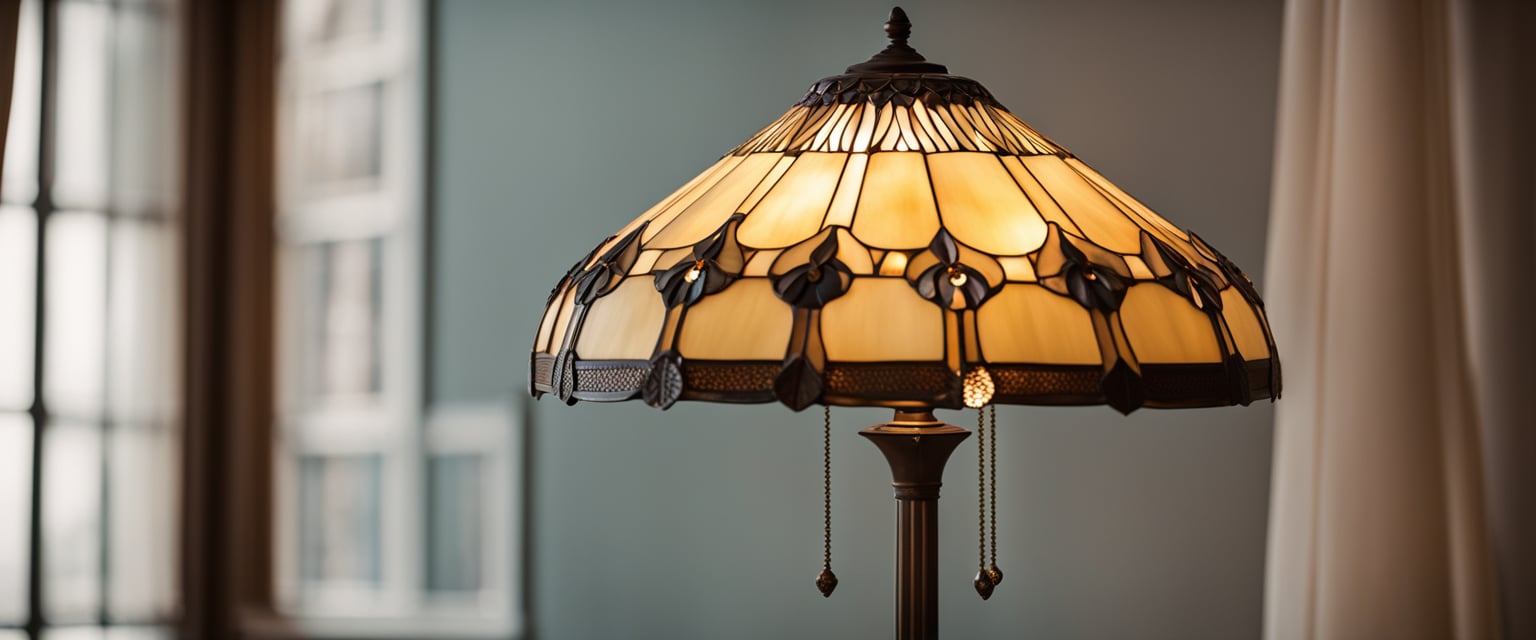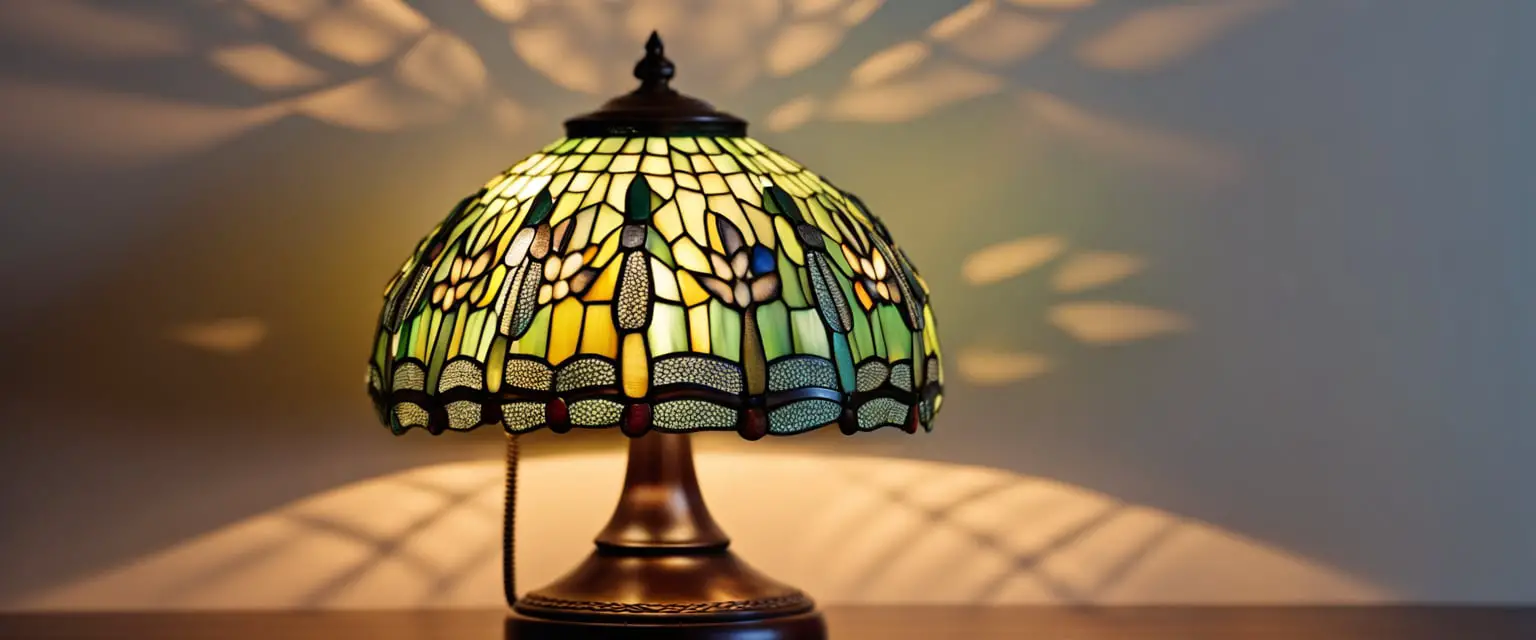Tiffany Studios, founded by Louis Comfort Tiffany, was renowned for its innovative stained glass creations, including iconic lamps, windows, and decorative objects. The term “Tiffany Studios” evokes a legacy of exquisite artistry and craftsmanship, symbolizing a golden era of design and creativity that continues to inspire and captivate art enthusiasts and collectors around the world.
This post serves to illuminate the rich legacy of Tiffany Studios, offering a captivating exploration of its pioneering contributions to the art of stained glass and decorative design. Whether you’re a dedicated collector seeking to delve into the history of Tiffany Studios or simply intrigued by the timeless beauty of stained glass art, this post unveils the enduring impact and artistic brilliance that define the legacy of Tiffany Studios.

Table of Contents
History of Tiffany Studios
Founding and Louis Comfort Tiffany
Tiffany Studios was founded in 1880 by Louis Comfort Tiffany, the son of the founder of Tiffany & Co. The company produced various decorative objects, including stained glass windows, lamps, pottery, and jewelry. Louis Comfort Tiffany was the artistic director of Tiffany Studios and was known for his innovative designs and use of color.
World’s Columbian Exposition Impact
Tiffany Studios gained international recognition at the World’s Columbian Exposition in Chicago in 1893. The company’s exhibit, which included a chapel interior featuring stained glass windows, won multiple awards and brought Tiffany Studios to a wider audience. The exhibit’s success helped establish Tiffany Studios as a leading producer of decorative objects.
Evolution into a Cultural Icon
Tiffany Studios continued to produce innovative designs throughout the early 20th century. The company’s work was featured in prominent public buildings, including the White House, and was collected by wealthy individuals worldwide. Tiffany Studios became a symbol of luxury and refinement, and its designs continue to be highly sought after by collectors today.
In addition to its artistic achievements, Tiffany Studios also played an important role in the cultural history of New York City. The company’s showroom on Madison Avenue was a popular destination for visitors to the city, and its designs helped define the aesthetic of the Gilded Age. Today, Tiffany Studios is remembered as one of the most important decorative arts companies of the late 19th and early 20th centuries.
Artistic Contributions
Tiffany Studios significantly contributed to the art world, particularly in glassmaking, decorative arts, and jewelry. Their influence on American art is undeniable, and their legacy inspires artists today.
Innovation in Glassmaking
Tiffany Studios was renowned for its innovative use of glass in its creations. Louis Comfort Tiffany, the studio’s founder and artistic director, developed a type of glass known as Favrile Glass, prized for its iridescent quality and unique colors. This glass was used in various creations, including lamps, vases, and windows.
The studio also employed a team of skilled glass cutters and designers, including many women who worked in the Women’s Glass Cutting Department. These women made significant artistic contributions to the studio’s creations, although their work was often uncredited.
Decorative Arts and Jewelry
In addition to glassmaking, Tiffany Studios was also known for its decorative arts and jewelry. The studio produced various decorative objects, including bronze sculptures, pottery, and enamelware. Many of these objects featured intricate designs and were highly sought after by collectors.
Tiffany Studios also produced a range of jewelry, including necklaces, brooches, and rings. The studio’s jewelry was known for using colorful gemstones and intricate metalwork. Many of these pieces were inspired by nature, featuring designs such as flowers, leaves, and birds.
Influence on American Art
Tiffany Studios significantly influenced American art, particularly in the late 19th and early 20th centuries. The studio’s innovative use of glass and its focus on craftsmanship and design helped elevate decorative arts to fine art.
The studio’s influence can be seen in the work of many American artists, including Frank Lloyd Wright. Wright was a friend of Louis Comfort Tiffany and was inspired by his use of glass in his designs. Tiffany Studios also helped establish the Art Nouveau movement in America, which was characterized by its use of natural forms and intricate designs.
Signature Creations
Tiffany Studios is known for its exquisite craftsmanship and unique designs. The company’s signature creations include lamps, stained glass windows, pottery, and other crafts.
Tiffany Lamps and Lighting
Tiffany lamps are renowned for their intricate designs and use of colorful glass. These lamps were first introduced in the late 19th century and quickly became popular among the wealthy. The lamps were made of bronze and featured intricate patterns and designs on their shades. Tiffany lamps were often inspired by nature, featuring flowers, leaves, and insects.
The base of a Tiffany lamp is just as important as the shade. Some Tiffany lamps feature bronze bases, while others are made of other materials, such as pottery or marble. Collectors highly prize Tiffany lamps, which can fetch high prices at auction.
Stained Glass Windows
Tiffany Studios is also known for its stained glass windows. These windows were often commissioned for churches, public buildings, and private homes. The windows featured intricate designs and were made of colorful glass.
Tiffany’s use of opalescent glass, a new type of glass at the time, gave his windows a unique and vibrant look. The windows often featured religious scenes, landscapes, and other decorative motifs.
Pottery and Other Crafts
Tiffany Studios produced lamps, stained glass windows, pottery, and other crafts. The company’s pottery was often inspired by nature, with many pieces featuring floral motifs.
Tiffany also produced other crafts like vases, bowls, and candlesticks. These items were often made of bronze and featured intricate designs and patterns.
The Tiffany Girls
Tiffany Studios is known for producing some of history’s most beautiful and intricate stained glass lamps and windows. However, many people don’t know that a group of talented women, the Tiffany Girls, played a significant role in creating these masterpieces.
Clara Driscoll and the Designers
Clara Driscoll was the head of the Women’s Glass Cutting Department at Tiffany Studios. She was responsible for designing many iconic lamps associated with the company. Driscoll was a talented artist who could create intricate designs that were both beautiful and functional. She was also a skilled manager who led a team of gifted women.
Driscoll’s designs were inspired by nature, and she often used flowers and other natural elements in her work. One of her most famous designs was the Wisteria lamp, which featured cascading purple flowers. This lamp was a masterpiece of design and craftsmanship, still highly sought after by collectors today.
Women’s Glass Cutting Department
The Women’s Glass Cutting Department consisted of talented women who were responsible for selecting and cutting the glass used in Tiffany lamps and windows. These women were highly skilled and could precisely cut glass into intricate shapes and patterns.
The women in the Glass Cutting Department were known for their attention to detail and ability to work quickly and efficiently. They were also known for their ability to work together as a team, which was essential in creating the complex designs that Tiffany Studios was known for.
Tiffany Studios Legacy
Tiffany Studios, established in 1880 by Louis Comfort Tiffany, has left an indelible mark on the world of decorative arts. The brand’s legacy is as rich and storied as its output, and it continues to inspire and influence artists and designers.
Museum Collections
Tiffany Studios’ work can be found in museums and galleries worldwide. The Chrysler Museum in Virginia boasts an extensive collection of Tiffany glass, including a stunning chandelier that once hung in the Bella Apartments in New York City. The Boston Museum of Fine Arts also has an impressive collection of Tiffany glass, including a stunning stained glass window depicting a peacock.
Tiffany Studios in Modern Times
Today, Tiffany Studios’ legacy lives on through the work of contemporary artists and designers inspired by the brand’s innovative and unique designs. Tiffany’s influence can be seen in everything from jewelry to home decor.
In recent years, there has been renewed interest in Tiffany Studios’ work, with many galleries and museums hosting exhibitions showcasing the brand’s iconic designs. These exhibitions have introduced a new generation of art lovers to the beauty and craftsmanship of Tiffany’s work, ensuring that the brand’s legacy will continue to inspire and captivate for years to come.
Tiffany Studios Locations
Tiffany Studios was a prominent decorative arts firm in the United States from 1878 to 1933. Throughout its history, the company had several locations, including its headquarters in Corona, New York, and a gallery and exhibition space in Boston.
Corona, New York Headquarters
Tiffany Studios’ headquarters were in Corona, New York, with a large manufacturing facility and design studio. The facility was on a sprawling estate with a mansion, gardens, and a greenhouse. The company employed hundreds of artisans and craftsmen on various projects, including stained glass windows, lamps, mosaics, and ceramics.
Boston Gallery and Exhibitions
In addition to its headquarters in Corona, New York, Tiffany Studios also maintained a gallery and exhibition space in Boston. The gallery, located in the city’s fashionable Back Bay neighborhood, featured a wide range of decorative arts objects produced by the company. The space was designed to showcase the company’s work and attract potential clients.
Tiffany Studios’ Boston gallery was important to the company’s marketing strategy. It allowed the firm to reach a wider audience and showcase its products in a sophisticated and elegant setting. The gallery also hosted special events, such as lectures and receptions, which helped promote the company’s brand and reputation.
Techniques and Materials
Tiffany Studios was known for its innovative techniques and materials, which transformed the art of glassmaking. The Favrile Glass Process and Blown Favrile Glass are two of its most famous techniques.
Favrile Glass Process
The Favrile Glass Process, patented by Louis Comfort Tiffany in 1894, was a revolutionary technique that produced iridescent glass with a unique texture and color. This process involved mixing different metallic oxides into the glass while it was still molten. The oxides would then react with the glass, creating a beautiful and unique iridescent effect.
Tiffany Studios used this process to create various glass objects, including vases, bowls, and lampshades. The Favrile Glass was known for its multiple colors, including deep blues, greens, purples, warm oranges, yellows, and reds. The glass had a distinctive texture, with a smooth and rippled surface.
Blown Favrile Glass
Tiffany Studios also used blown favrile glass to create unique glass objects. This technique involved blowing air into the molten glass, creating a bubble that expanded as the glass cooled. The glassblower could shape the bubble into various forms, creating vases, bowls, and other objects.
Tiffany Studios used Blown Favrile Glass to create various lampshades, including the iconic “Dragonfly” and “Wisteria” designs. These lampshades featured intricate patterns and colors, carefully selecting and arranging each piece of glass to create a beautiful and harmonious whole.
Tiffany Studios and Tiffany & Co
Distinct Identities and Relations
Tiffany Studios and Tiffany & Co are distinct entities with a familiar name. Tiffany & Co. was founded by Charles Lewis Tiffany in 1837 and is famous for its luxury jewelry and silverware. On the other hand, Tiffany Studios was established by Charles’s son, Louis Comfort Tiffany, in 1902. It is renowned for its stained glass lamps and windows, mosaics, blown glass, and other decorative arts.
Despite their shared name, Tiffany Studios and Tiffany & Co. had different business models and target markets. While Tiffany & Co. catered to the elite class with its high-end jewelry and silverware, Tiffany Studios targeted the middle class with its more affordable decorative arts.
However, there were some overlaps between the two companies. For example, Tiffany & Co. occasionally sold Tiffany Studios’ decorative arts in its stores. Additionally, Louis Comfort Tiffany was the artistic director of Tiffany & Co. from 1902 to 1919, and some of his designs were used in Tiffany & Co.’s jewelry and silverware.
In 1932, Tiffany & Co. bought Tiffany Studios’ remaining inventory and intellectual property, effectively ending the latter’s operations. Both companies are still recognized for their contributions to the decorative arts and luxury goods industries, albeit in different areas.
| Tiffany Studios | Tiffany & Co |
|---|---|
| Established by Louis Comfort Tiffany in 1902 | Established by Charles Lewis Tiffany in 1837 |
| Renowned for stained glass lamps and windows, mosaics, blown glass, and other decorative arts | Famous for luxury jewelry and silverware |
| Targeted the middle class with more affordable decorative arts | Catered to the elite class with high-end jewelry and silverware |
| It is still in operation today as a luxury goods company | Louis Comfort Tiffany was the artistic director from 1902 to 1919, and some of his designs were used in Tiffany & Co’s jewelry and silverware |
| Bought by Tiffany & Co in 1932, effectively ending its operations | Bought by Tiffany & Co. in 1932, effectively ending its operations |
Frequently Asked Questions
What is the history behind Tiffany Studios’ stained glass art?
Tiffany Studios was a decorative arts company founded by Louis Comfort Tiffany in 1902. The company was best known for producing stained glass windows, lamps, and mosaics. Tiffany Studios was a major force in the Art Nouveau movement, characterized by its use of organic forms and motifs. The company produced some of the most iconic and beautiful stained glass art of the 20th century.
How can one identify an authentic Tiffany Studios lamp?
Collectors highly seek after Authentic Tiffany Studios lamps, which can be worth millions of dollars. One should look for several key features to identify an authentic Tiffany Studios lamp. These include the signature “Tiffany Studios New York” mark on the company’s pieces. Authentic lamps will also have high-quality materials like leaded glass and bronze. Finally, authentic Tiffany Studios lamps will have a unique and intricate design, with attention paid to every detail.
What were the most iconic creations by Tiffany Studios?
Tiffany Studios produced various decorative arts, including lamps, windows, mosaics, and jewelry. Some of its most iconic creations include the Tiffany lamp, which was first produced in 1899, and the stained glass windows of the Mark Twain House in Hartford, Connecticut. The company was also known for using innovative techniques, such as the Favrile glass technique, which produced a distinctive iridescent effect.
How did Tiffany Studios impact the Art Nouveau movement?
Tiffany Studios was a major force in the Art Nouveau movement, characterized by its use of organic forms and motifs. The company’s use of innovative techniques and high-quality materials helped elevate the status of decorative arts, and its work was highly influential in developing the Art Nouveau style. Tiffany Studios played a key role in creating American decorative arts, and its legacy continues to be felt today.
What is the relationship between Tiffany Studios and Louis Comfort Tiffany?
Louis Comfort Tiffany was the founder and creative force behind Tiffany Studios. He was a renowned artist and designer whose work helped define the Art Nouveau style. Tiffany Studios culminated his lifelong passion for decorative arts, and the company produced some of the most beautiful and innovative decorative arts of the 20th century.
Where can collectors find original Tiffany Studios pieces?
Collectors highly seek after original Tiffany Studios pieces and can be found in several locations.
Some of the best places to find original Tiffany Studios pieces include museums, such as the Metropolitan Museum of Art in New York City.
Auction houses like Sotheby’s and Christie’s are also good places to look.
Collectors should be aware that authentic Tiffany Studios pieces can be quite expensive.
They should ensure that they are purchasing from a reputable dealer.



Leave a Reply